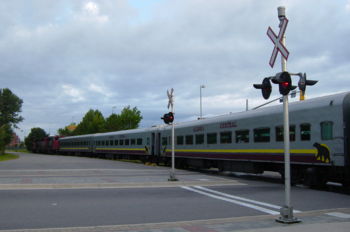Algoma Central Railway
| Algoma Central Railway | |
|---|---|
| logo | |
| Reporting marks | AC, ACIS |
| Locale | Northern Ontario |
| Dates of operation | 1899 – 2001 |
| Track gauge | 4 ft 8½ in (1435 mm) (standard gauge) |
| Headquarters | Sault Ste. Marie, Ontario |
The Algoma Central Railway (AAR reporting marks AC, ACIS) was a railway in Northern Ontario that ran between Sault Ste. Marie and Hearst, with a branch line to Michipicoten. The area served by the railway is sparsely populated, with few roads. The railway is well known for its Agawa Canyon tour train. The railway was purchased by Wisconsin Central in 1995, which was in turn purchased by Canadian National Railway in 2001. It is now operated as part of CN's Eastern Division.
History
The Algoma Central Railway was initially owned by Francis H. Clergue, who required a railway to haul resources from the interior of the Algoma District to Clergue's industries in Sault Ste. Marie; specifically, to transport logs to his pulp mill and iron ore from the Helen Mine near Wawa to a proposed steel mill (which was later named Algoma Steel). The Algoma Central Railway was chartered on August 11, 1899. [1] The railway's Dominion and provincial charters gave it authority to build north from Sault Ste. Marie to a junction with the Canadian Pacific Railway's main line, as well as a branch line to Michipicoten Harbour, on Lake Superior near Wawa.
In 1901 Clergue acquired the charter of the Ontario, Hudson Bay and Western Railway, who were intending to build a line between the CPR main line and Hudson Bay and then changed the name of the Algoma Central Railway to the Algoma Central and Hudson Bay Railway, anticipating a connection either to Moose Factory on James Bay, or to some point on Hudson Bay.
The Algoma Central fell victim to the bankruptcy of Clergue's Consolidated Lake Superior Corporation in 1903.[1] At that time, the line reached 56 miles north of Sault Ste. Marie with a 20 mile segment running east from Michipicoten Harbour that did not yet connect with the main line. Construction was stopped, but was resumed in 1909 and the line was extended northward through to junctions with the Michipicoten Harbour branch (at Hawk Junction), the Canadian Pacific Railway (at Franz) and the Canadian Northern Railway (at Oba). In 1914 it finally reached Hearst, a town 296 miles north of Sault Ste. Marie that was a divisional point on the National Transcontinental Railway.[1] By that point, Clergue's dream of building a railway to Hudson Bay or James Bay had long been abandoned, and the railway's northern terminus remained at Hearst, around 150 miles from James Bay. However, the phrase and Hudson Bay was not removed from the railway's name until June 30, 1965.
The Algoma Central was the first Canadian railway to fully dieselize, in 1952. [2]

In the 1960s, the railway began to promote the natural beauty of the District of Algoma to tourists, especially the Agawa Canyon, a canyon around the Agawa River, 114 rail miles north of Sault Ste. Marie that is not accessible by road.[3] The Algoma Central developed a tourist stopover here, which was a great success for the railway. Due to the popularity of the Agawa Canyon excursions, the Algoma Central would run the longest passenger trains in North America, often up to 20 to 24 cars long. During the 1970s and 1980s around 100,000 people per year would tour Agawa Canyon.
The railway had been in the shipping business since 1900, when it had purchased four steamships. Starting around the 1960s, the railway greatly expanded its marine operations and diversified into trucking, real estate, forestry, and mining operations. These operations were more profitable than the railway operations, and on April 30, 1990, as part of a corporate reorganization, the name of the company was changed to Algoma Central Corporation, and the Algoma Central Railway became a subsidiary of it.[4] A few years later the Algoma Central Railway was put up for sale. On February 1, 1995, Wisconsin Central Ltd. purchased Algoma Central Railway Incorporated, operating the railway as a separate subsidiary, Wisconsin Central Canada Holdings. In 1998, Algoma Steel closed its iron ore mine in Wawa, and the branch line between Michipicoten Harbour and Hawk Junction was abandoned.[2] Wisconsin Central Ltd. was acquired by Canadian National on October 9, 2001, whereupon the Algoma Central became part of CN's Eastern Division.
The railway is the subject of a song by Stompin' Tom Connors.
References
- ↑ 1.0 1.1 1.2 Wilson, Dale (1984). The Algoma Central Railway Story. Sudbury, Ontario: Nickel Belt Rails. ISBN 0-920356-05-2.
- ↑ 2.0 2.1 Boldt, Hans; S. Grisonich-Boldt. Algoma Central Railway. Retrieved on 2006-12-15.
- ↑ Algoma Central Railway FAQ. Canadian National Railway. Retrieved on 2006-12-15.
- ↑ (1990-06-01) "Algoma changes its name to inform investors it's more than a railway". Northern Ontario Business 10 (9): 16.
External links
|
Current (operating) regional railways of Canada Former or fallen flag regional railways of Canada |
|
Current (operating) short line railways of Canada |
|
Former or fallen flag short line railways of Canada |

